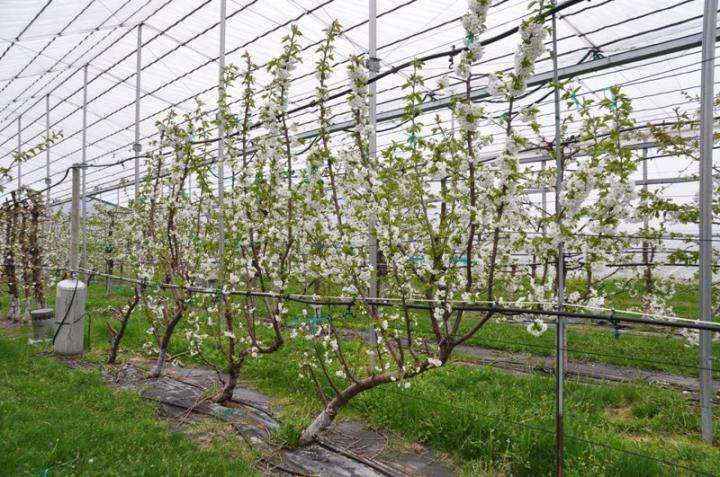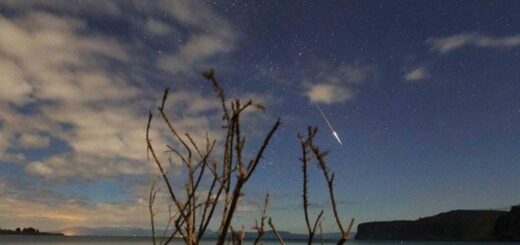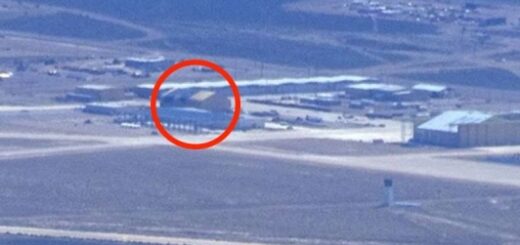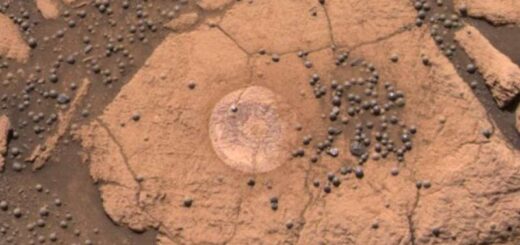How UFOs can improve sweet cherry production

Sweet cherry growers must address many challenges to producing marketable crops, including high labor costs, pests, diseases, rain-induced cracking, and bird damage. The authors of a new study (HortScience, August 2016) say that high-density tree training systems can help growers make sweet cherry production more efficient and reduce pesticide use. Tiffany Law and Gregory Lang, from the Department of Horticulture at Michigan State University, evaluated the first-year establishment of upright fruiting offshoots (UFO) of sweet cherry trees, and determined effective practices that they say can increase grower’s success.
Law and Lang explained that UFO is an innovative and somewhat radical new high-density training system that produces fruit on multiple vertical leaders (offshoots) arising from a cordon-like trunk, ostensibly somewhat like trellised grapes. “This provides a tall, narrow fruiting canopy that is easy to train and prune for renewal of uprights,” the authors said. “The goal in establishing a UFO tree structure is to develop well-distributed upright shoots and maximize vertical shoot growth in the trellis plane.”
Lang and Law experimented with unbranched single leader nursery trees of ‘Rainier’ sweet cherry on ‘Gisela 3’ rootstock, planted at a spacing of ≈1.5 m and divided into 12 treatment combinations. The experiments investigated trunk angle, planting trees at 30°, 45°, or 60° from horizontal. “Imposed on the angle factor was the height at which the trunk was attached horizontally to the first trellis wire (45 or 60 cm), and bent in early summer to form the horizontal cordon,” the authors reported.
To determine the influence of bud selection on shoot development, the scientists either left all buds intact or removed most buds except one upward-oriented bud every ≈15 cm.
Planting angle, cordon height, and bud selection all significantly impacted canopy establishment of UFO trees. At planting, trunk angles of 45° or 60° from the horizontal resulted in increased upright shoot growth compared with 30°, and also promoted better shoot distribution on the treatments without bud selection. A cordon height of 45 cm increased total upright shoot length by 20% compared with a 60-cm cordon height.
Bud selection improved canopy development precision by promoting a more balanced distribution of upright shoots across the cordon, reducing the number of shoots in the terminal third of the cordon and increasing shoot number in the basal and middle thirds compared with no bud selection. “Bud selection reduced fruiting potential in the 2nd and 3rd years compared with unmanaged treatments, but subsequently surpassed those treatments in projected annual yield in Year 4 and cumulative yield in Year 5,” the authors noted. Bud selection increased total and average upright shoot length, and improved distribution during establishment while moderating early crop load potential.
The study contains additional recommendations for production practices that can improve precision canopy development and full yield potential for sweet cherry production in the upright fruiting offshoots system, which is of increasing interest to growers for its potential to optimize labor efficiency and cropping uniformity.



 Creators of mankind
Creators of mankind Description of “Tall white aliens”
Description of “Tall white aliens” Where they came from?
Where they came from? About hostile civilizations
About hostile civilizations The war for the Earth
The war for the Earth “Tall white aliens” about eternal life
“Tall white aliens” about eternal life Video: “Nordic aliens”
Video: “Nordic aliens” Aliens
Aliens Alien encounters
Alien encounters The aliens base
The aliens base UFO
UFO Technology UFO
Technology UFO Underground civilization
Underground civilization Ancient alien artifacts
Ancient alien artifacts Military and UFO
Military and UFO Mysteries and hypotheses
Mysteries and hypotheses Scientific facts
Scientific facts


















